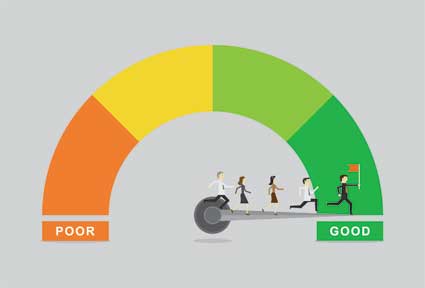Statement of Cash Flow Overview:
The generally accepted accounting principles mandate that the statement of cash flows be included in a complete set of financial statements for business. In a real world business environment, cash flow the main lifeline of a business entity, and managing this cash flow is critical to the long-term prosperity of the business. The main goal of the statement of cash flows is to provide information regarding how a business generated cash, the cash receipts and cash payments of the business during a given time. The cash flow statement also referred to as the statement of cash flows allows business owners and managers to examine current cash balances and to make forecasts of the future cash flows of the business. Business owners, managers, banks, and investors to make calculated financial decisions use the information that is provided in the cash flow statement.
The statement of cash flows is unique in that it is one of the only financial statements that shows what happened to a business's cash for the given. Generally the income statement does not provide much help on cash flow is a matter of fact the income statement can sometimes be misleading when examining cash. Example of this is when a business makes a profit as recorded in the income statement, while simultaneously not having enough cash to me its current liability obligations.
|
Learning Objectives |
|
• You should be able to accurately and succinctly describe the type of information that is included in the cash flow statement, its use and its organization. |
|
• You should be able to recognize and describe the various types of cash flows better important for business owners and managers who make decisions regarding the financial activities of a business, as well as how cash flows are reported. |
|
• You should be able to recognize and describe the various types of cash flows better important for business owners and managers who make decisions regarding the financial activities of a business, as well as how cash flows are reported. |
6.1) The Classifications and Organization of the Statement of Cash Flow:
Accounting rules state that the cash flows for a business must be categorized in three ways. These three ways are known as cash flows from operating activities, cash flows from investing, and cash flows from financing. Business owners as well as investors are both interested and entities that produce sufficient cash flow from their operations. One way to measure if the cash flow sufficient or not is to find the free cash flows, which we would discuss later in this article.
Operating Activities-
The first classification of cash flows is known as the cash flows from operations. The operating cash flows are generated from the normal day today activities of a business. These type of cash flows can generally be considered as routine and likely reccurring. The cash flows from operations are considered uniquely vital because most businesses must be able to generate positive cash flows from their daily business operations over long periods of time in order to remain economically viable.
|
Example: Cash Flows from Operating Activities |
|
• The cash receipts and collection that a business incurs from the sale of goods and or services |
|
• Payments made to the suppliers of a business |
|
• Payments made to the employees of a business |
|
• Interest payments made on money that a business owes |
|
• Tax payments made by a business to the government |
Investing Activities-
Cash flow from investing activities shows the change in a business's cash holdings or positions from any gains or losses that occurred as a result from investments. These cash flows are related to noncurrent assets. Noncurrent assets include:
1.) Property and equipment
2.) Investments of cash such in foreign currency or government bonds
3.) Intangible assets such as patents and other intellectual property
The types of investments on the cash flow statement can be things such as a financial stake in an operating subsidiary company, capital investments in the "plant and equipment" (business and necessary supplies to run the business), as well as the financial markets. Additionally the statement of cash flow businesses will have activities such as making loans and collecting on those loans, acquiring new property, dumping of debt, selling equity instruments, and other assets that produce cash flows for the business.
|
Example: Cash Flows from Investing Activities |
|
• The cash receipts generated from the sale of productive assets |
|
• The payments made for the purchase of securities of other businesses |
|
• The cash receipts generated from the sale of securities of other businesses |
|
• The payments that are made during the purchase or acquisition of productive assets |
Financing Activities-
The cash flows from financing show amounts of money that have been received from issuing stock, the repurchase of stock, dividend payments made to stock owners, borrowing money from a bank or lending institution, and payments that are made to retire debt. In the statement of cash flows dirt is an additional category that is sometimes reported and relates to noncash activities. These noncash activities artifacts related to financing, or investing, but they do not actually generate or use any cash. An example of this might be if a business has convertible bonds outstanding, than the conversion of these bonds into common stock it's considered a material change in the financing activities but does not actually affect cash.
|
Example: Cash Flows from Investing Activities |
|
• The money generated from issuing equity securities for a business |
|
• The money generated from issuing debt securities or obtaining loans |
|
• The dividend payments made buy a business to shareholders |
|
• The payment made for repurchase of stock or other equity securities of a business |
|
• The payments made on the principle of loans that the business has received from a lending institution |
Cash Flows from Operations-
The cash flows from operations are generally considered the most important because they deal with cash that it is generated by businesses primary activities. It's these activities and the related cash flows that are considered recurring. The statement of cash flows is a type of reconciliation. This means that it reflects what happened to the cache of a business during a particular accounting period. In accounting there are two methods of presenting the statement of cash flows. The difference between these two methods lies in the way that the operating cash flows are reported. These two methods are known as the direct method and the indirect method. Both the direct method as well as the indirect method will yield the same results, however different procedures are used to derive the cash flows.
Operating Activities- Methods of Preparing a Statement of Cash Flows:In accounting there are two methods of presenting the statement of cash flows. The difference between these two methods lies in the way that the operating cash flows are reported. These two methods are known as the direct method and the indirect method. Both the direct method as well as the indirect method will yield the same results, however different procedures are used to derive the cash flows.
Direct Method:
The first method of reporting cash flows from operating activities that we will discuss is known as the direct method. The FASB generally recommends that companies present the statement of cash flows using the direct method format, however most companies prefer to use the indirect method due to its ease of construction. The direct method focuses on cash flows directly rather than beginning with net income and adjusting for the non-cash items. With this method the operating section am statement of cash flows reports the cash that is received from customers, the dividends received from investments or cash from interest, cash that is received from income sources, cash that is paid by the business for taxes and interest paymentsd, as well as the cash payments made by a business to its suppliers and its employees. The non-cash revenues and expenses of a business along with all of the nonoperating gains and losses, are excluded because they have no direct effect on cash flow. Generally with the direct method it is considered to be more logical an understandable then compared to the indirect method. However, a separate reconciliation with net income is needed. With regard to investing and financing section of the of the statement, they are reported the same under both the direct method is always indirect method.
Use either the direct or the indirect method, you will arrive at the same cash from operations, however the difference is that the direct method focuses on the cash flows, and conversely the indirect method tend to focus on the net income and adjusting it in order to ascertain the net cash flow from operations. Additionally the indirect method will allow the county or the business to be able to tie the statement of cash flows to the other financial statements with greater ease, while the direct method gives the end-user a more logical presentation of the financial information.
|
WH3 Corp. |
||
|
Statement of Cash Flows (Direct Method |
||
|
For the Years Ending December 31, 2006 and December 31, 2005 |
||
|
2006 |
2005 |
|
|
Cash Flows from Operating Activities |
||
|
Collections |
$52,134 |
$45,029 |
|
Payments to Suppliers |
$564 |
$345 |
|
Payments to Employees |
5709 |
5413 |
|
Insurance Payments |
230 |
230 |
|
Interest Payments |
410 |
410 |
|
Other Source/(Uses) of Cash |
330 |
330 |
|
Net Cash from Operating Activities |
$59,377 |
$51,757 |
|
Cash Flows from Investing Activities |
||
|
Increase in Marketable Securities |
$13,194 |
$12,245 |
|
Sale of Fixed Assets |
25000 |
10000 |
|
Purchase of New Equipment |
1432 |
809 |
|
Other |
0 |
0 |
|
Net Cash Used for Investing Activities |
$39,626 |
$23,054 |
|
Cash Flows from Financing Activities Interested in learning more? Why not take an online Understanding Financial Statements course?
|
||
|
Payment of Mortgage Principal |
$1,203 |
$1,203 |
|
Transfer From/(To) Parent |
5531 |
4312 |
|
Other |
0 |
0 |
|
Net Cash from Financing Activities |
$6,734 |
$5,515 |
|
NET INCREASE/(DECREASE) IN CASH |
$105,737 |
$80,326 |
|
CASH, BEGINNING OF YEAR |
100326 |
20000 |
|
CASH, END OF YEAR |
$206,063 |
$100,326 |
Indirect Method:
Generally when reporting the operating section of the statement of cash flows most companies use the indirect method. With the indirect method the business is able to start with an accrual basis net income and then adjust that figure to get the cash that is generated from operations or that is used by operations. Even though accrual-based income is typically regarded as the preferred metric of operating success for a business, it still does not tell the user the amount of cash flows from operating and therefore has to be adjusted for all of the items that will affect income and cash in different ways. This section over the indirect method will include the following adjustments that should be made two net income in order to understand and analyze the cash that is generated from operations of a business used in the operations of a business:
|
WH3 Corp. |
||
|
Statement of Cash Flows (Indirect Method) |
||
|
For the Years Ending December 31, 2003 and December 31, 2002 |
||
|
2003 |
2002 |
|
|
Cash Flows from Operating Activities |
||
|
Net Income |
$55,203 |
$51,293 |
|
Add Expenses Not Requiring Cash: |
||
|
Depreciation |
803 |
983 |
|
Amortization of Goodwill |
0 |
0 |
|
Other |
0 |
0 |
|
Other Adjustments: |
||
|
Add Reduction in Accounts Receivable |
5709 |
5413 |
|
Add Increase in Wages Payable |
100 |
100 |
|
Add Increase in Accounts Payable |
230 |
230 |
|
Subtract Decrease in Accounts Payable |
100 |
200 |
|
Subtract Increase in Inventory |
10 |
15 |
|
Subtract Increase in Prepaid Expenses |
0 |
0 |
|
Other |
0 |
0 |
|
Net Cash from Operating Activities |
$62,155 |
$58,234 |
|
Cash Flows from Investing Activities |
||
|
Increase in Marketable Securities |
$13,194 |
$12,245 |
|
Sale of Fixed Assets |
25000 |
10000 |
|
Purchase of New Equipment |
1432 |
809 |
|
Other |
0 |
0 |
|
Net Cash Used for Investing Activities |
$39,626 |
$23,054 |
|
Cash Flows from Financing Activities |
||
|
Payment of Mortgage Principal |
$1,203 |
$1,203 |
|
Transfer From/(To) Parent |
5531 |
4312 |
|
Other |
0 |
0 |
|
Net Cash from Financing Activities |
$6,734 |
$5,515 |
|
NET INCREASE/(DECREASE) IN CASH |
$108,515 |
$86,803 |
|
CASH, BEGINNING OF YEAR |
106803 |
20000 |
|
CASH, END OF YEAR |
$215,318 |
$106,803 |
|
1.) Cash payments that have been made in the current period for expenses that were incurred during other periods must be deducted. |
|
2.) Any expenses that reduce the net income for the current period by did not use any cash must then be added back. |
|
3.) Any revenues of a business that did not result in and inflow of cash during the current period must then be deducted. |
|
4.) The cash collections for revenues that were earned during other periods have to be added. |
|
5.) Any items that were reported in the income statement but were not directly related to the standard operations of a business must then be removed. |
Free Cash Flows:
One of the most important concepts from an operational and investment point of view when dealing with cash flow is known as "free cash flow". Free cash flow indicates the amount of cash that the business has available for its activities after allowances have been made for financing and investing activity requirements to maintain the normal level of productivity in the business. Formula for free cash flows is based on the net cash from operating activities (NCOA), and subtracts both dividends paid as well as capital expenditures. Many business valuations are done on a free cash flow basis as it shows the cash that is left over after all of the expenses required to operate the business on a day-to-day basis have been taken out. This is also extremely useful from a financial investor point of view because it allows the investor to determine whether or not the business is generating enough free cash flow to maintain activities if the business is in a down market or experiencing seasonal trends.
An example of this would be if the price of oil were to crash a company with little to no free cash flow would be in a very bad position where it might have to look for outside sources of financing, or it might have to sell off assets in order to generate cash. An additional example would be a car dealership experiencing seasonal purchasing pattern trends where there is a large volume of sales towards the end of the year in the beginning of the next year experiences a low sales volume thereby requiring that the car dealership still be able to generate enough free cash flow pay its daily operating obligations or it might have to find sources of outside financing or sell off assets putting it in a similar position to the oil company in the previous example. Generally companies we usually disclose their total capital expenditures in the statement of cash flow however they will rarely disclose capital expenditures required for sustaining productive capacity of the business. Therefore out of practicality many accounts and financial analysts often use the total capital expenditures of the business in the formula for free cash flows listed below.
|
Formula To Calculate Free Cash Flow |
|
Free Cash Flow = Net Cash from Operating Activies (NCOA) – ( Capital Expenditures + Dividends Paid ) |
Free Cash Flows for WH3 Corp. (2003-2005)
|
( $ In Thousands) |
2005 |
2004 |
2003 |
|
|
NCOA |
$ 182,115 |
$ 185,195 |
$ 215,588 |
A |
|
Capital Expenditures |
71,706 |
69,136 |
83,481 |
B |
|
Dividends Paid |
13,834 |
67, 864 |
105,078 |
C |
|
Free Cash Flow |
$ 96,575 |
$ 48,197 |
$ 27,029 |
A - (B + C) |
Adequacy of Cash Flow:
Cash flow adequacy is another important metric that evaluates if the cash flow from the operating activities of the business is enough or adequate enough to cover the annual payment requirements of a business. This ratio answers the question of, "Is there enough net cash from operating activities available in order to maintain the productive capacity of the business at its current levels?" This ratio also presents the free cash flow information for the business in a format that is used by many credit rating agencies in order to identify if the business has enough cash to cover its debt, capital expenditures, annual payment obligations, and dividends.
The cash flow adequacy ratio of 1.0 or higher tends to indicate that the cash flows for a business are high enough to sustain and pay for its capital expenditures as well as dividends. When the cash adequacy ratio for a business is below 1.0 that would tend to indicate that the business does not have enough cash flow to cover its obligations. You can think of this in terms of percentages meaning that a ratio of 1.0 tells the user that the business can cover 100% of its debt obligations and that a ratio of 1.25 shows that the business can cover 125% of its debt obligations. Similarly if the ratio is 0.5 then the business can only cover 50% of its debt obligations and if the ratio is 0.85 than the business can only cover 85% of its debt obligations.
|
Formulat to Calculate Adequacy of Cash Flow |
|
Adequacy of Cash Flow= (Net Cash from Operating Activities) / (Capital Expenditures + Dividends Paid) |
|
( $ In Thousands) |
2005 |
2004 |
2003 |
|
|
NCOA |
$ 182,115 |
$ 185,197 |
$ 215, 588 |
A |
|
Capital Expenditures |
71,706 |
69,136 |
83,841 |
B |
|
Dividends Paid |
13,834 |
67,864 |
105,078 |
C |
|
Cash Flow Adequacy |
2.13 |
1.35 |
1.14 |
A/(B + C) |
|
KEY POINTS REVIEW |
|
|
|
|
|
|
|


























